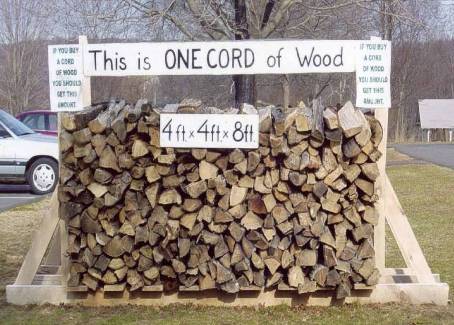Once we get a few cooler nights in Central North Carolina and folks remember that no matter how hot our summer, winter will still arrive, we notice an increase in client calls about the availability of local firewood. At Grateful Trees and Bee this means that in addition to answering questions about tree removals, tree pruning and timber sales, we get to answer one of our favorite queries:

“How much wood is in a cord?”
The short answer: A lot.
The long answer: You got a minute or twelve?
The tale of the infamous firewood cord starts out precise and scientific:
- The standard unit of measure for firewood is a cord;
- A cord measures 4-feet x 4-feet x 8-feet and has a volume of 128 cubic feet;
- The volume of pure firewood in a cord averages 85 cubic feet, with the remainder comprised of air.
And then, as is often the case with science, the human variable enters and the real story begins.
First, modern cordwood is rarely sold in its measurement length of 4-feet. Instead it is typically sold in pieces ranging from 12-inches to 18-inches in length. This shorter “cord” may be called a stove cord, furnace cord or face cord. To be able to determine the cost per cord, you’ll need to grab a tape ruler and a calculator. For example, a woodpile that’s 8-feet long and 4-feet high with pieces averaging 16-inches is equivalent to 1/3 of a cord (48-inches ÷ 16-inches = 3), so to determine your price per cord, multiply by 3.
Second, firewood is often not sold in a neat stack from a wood yard you can visit in person, but rather by the truckload, trailer-load, or some other unit that is difficult to convert to price per cord. To still pay a fair price per cord, consider the following:
- Ask the vendor for their estimate of how their volume compares to a cord measure, then determine the price per cord.
- Stack the wood after delivery and compute your price per cord so you know for the future how this vendor’s unit of measure compares to a cord.
- If you must buy the wood sight unseen, alert the vendor that you will be available when the wood is delivered and that you reserve the right to refuse the purchase.
- In some cases you may be willing to pay a higher cost per cord for:
- Firewood cut to length or more finely split, representing a greater labor investment;
- Well-seasoned wood which burns more efficiently (see: Firewood Season: Tips for Selecting & Storing Firewood);
- Delivery and stacking.
In the end, we recommend that you develop an ongoing relationship with a firewood vendor so that you can be certain of receiving clean, well-seasoned firewood at a fair price. We also strongly encourage you to look around you for what Nature has provided. Remember that most dead or downed trees on your property can be recycled into firewood.
© 2014 Grateful Trees & Bees

